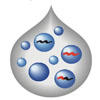 Identification and manipulation of the molecular determinants influencing poliovirus recombination.
Identification and manipulation of the molecular determinants influencing poliovirus recombination.Charles Runckel, Oscar Westesson, Raul Andino, Joseph DeRisi
PLoS Pathogen, 2013Abstract: The control and prevention of communicable disease is directly impacted by the genetic mutability of the underlying etiological agents. In the case of RNA viruses, genetic recombination may impact public health by facilitating the generation of new viral strains with altered phenotypes and by compromising the genetic stability of live attenuated vaccines. The landscape of homologous recombination within a given RNA viral genome is thought to be influenced by several factors, however a complete understanding of the genetic determinants of recombination are lacking. Here, we utilize gene synthesis and deep sequencing to create a detailed recombination map of the poliovirus 1 coding region. We identified over 57 thousand breakpoints throughout the genome and we show the majority of breakpoints to be concentrated in a small number of specific hotspots, including those associated with known or predicted RNA secondary structures. Nucleotide base composition was also found to be associated with recombination frequency, suggesting that recombination is modulated across the genome by predictable and alterable motifs. We tested the predictive utility of the nucleotide base composition association by generating an artificial hotspot in the poliovirus genome. Our results imply that modification of these motifs could be extended to whole genome re-designs for the development of recombination-deficient, genetically stable live vaccine strains.
